Voices Across the Water
Au fil de l’eau
Fritz Mueller
2022
| 84 min
Documentary
Original version in English
Awards and Festivals
Official SelectionAvailable Light Film Festival, Whitehorse, Canada (2023)
Official SelectionFIN Atlantic International Film Festival, Halifax, Nova Scotia (2022)
Official SelectionBanff Mountain Film Festival, Alberta (2022)
Official SelectionYellowknife International Film Festival, Canada (2022)
Official SelectionSalt Spring Film Festival, British Columbia (2023)
A Sagafish Media and National Film Board of Canada co-production
There is a moment during the construction of a canoe when its true form is revealed. A hull drops into place. The elegant arc of a bow cuts forth. A similar process sometimes occurs in life, when a person finally discovers their true path.
Fritz Mueller and Teresa Earle’s feature documentary Voices Across the Water follows two master boat builders as they practise their art and find a way back to balance and healing.
For Alaskan Tlingit carver Wayne Price and young apprentice, Violet, fashioning a dugout canoe from a single massive red cedar tree is a way to reconnect to the Ancestral Knowledge of Indigenous craftspeople. Francophone artist Halin de Repentigny’s handmade birchbark canoes recall the vessels once used by the voyageurs. Connected by their devotion to craft and the critical importance of succession, they carry forward the ancient art of navigating life’s unexpected currents.
Watch film – https://www.nfb.ca/film/voices-across-the-water/
Trailer
Poster
LONG SYNOPSIS
There is a moment during the construction of a canoe when its true form is revealed. A hull drops into place. The elegant arc of a bow cuts forth. A similar process sometimes occurs in life, when a person finally discovers their true path.
Fritz Mueller and Teresa Earle’s feature documentary Voices Across the Water follows two master boat builders as they practise their art and find a way back to balance and healing.
For Alaskan Tlingit carver Wayne Price, fashioning a dugout canoe from a single massive red cedar tree is a way to reconnect to the Ancestral Knowledge of Indigenous craftspeople. Wayne’s long hours of labour are buoyed by silly jokes and deep conversation with a new young apprentice, Violet.
Francophone artist Halin de Repentigny hand-makes birchbark canoes, like those once used by the voyageurs. Harvesting raw materials from the Yukon forest, Halin works in painstaking fashion to create his light, strong vessels, lovingly embellished with his fanciful artwork.
But what happens when the old ways are lost? For Wayne, building boats is a means to pass on his skill and expertise to the next generation, while Halin’s labour is more introspective, but both men understand the fragility of knowledge. Connected by their devotion to craft and the critical importance of succession, they carry forward the ancient art of navigating life’s unexpected currents and eddies.
In the final meeting of wood and water, the vessels are launched, carrying friends and family in joyous communion: their journey complete.
ONE-LINER & TWO-LINER
Two-liner
There is a moment during the construction of a canoe when its true form is revealed. A hull drops into place. The elegant arc of a bow cuts forth. A similar process sometimes occurs in life, when a person finally discovers their true path.
The feature documentary Voices Across the Water follows two master boat builders as they practise their art and find a way back to balance and healing.
One-liner
Voices Across the Water follows two master boat builders as they practise their art and find a way back to balance and healing.
INTERVIEW WITH DIRECTOR FRITZ MUELLER
Did you gain a greater appreciation for the healing effect of making things by hand after following these two different men on their respective journeys?
There’s a meditative quality to making something by hand; it’s similar to the ‘zone’ that athletes get into. A big part of Alaskan Tlingit carver Wayne Price’s and francophone artist Halin de Repentigny’s personal confidence is that they are masters at making something that is challenging. They’re both at their best and happiest when they are nearing completion of a canoe.
They talk about the rhythmic cadence of chipping, adzing and stitching bark to fashion boats. It requires a high level of focus and engagement. There’s also something about the paddling cadence. Wayne says there’s no space to be angry while canoeing, that paddling actually displaces negative thoughts. When you stay in a positive space for a long time, you form new patterns of thinking and emerge at the end a different person. I’m convinced that’s part of the healing process.
Does the art of building traditional boats offer a tangible, physical connection with the past? What is lost when these traditions no longer exist?
These styles of watercraft have been built for thousands of years. They’re etched into the human ethos, with significant space in stories and literature. Making these kinds of craft requires a high level of understanding of both materials and tools.
Both Wayne and Halin collect raw materials from their local environments and use tools that are directly connected to the past. Wayne believes the physical touch of wood and water helps define who we are and connects us to our ancestors.
Access to this knowledge keeps us grounded in the values and wisdom of the past, but it’s also an opportunity to better understand who we are in the current moment and the challenges of where we are going. Hopefully it makes us wiser.
Both Wayne and Halin are visual artists, as well as master boatbuilders. What role does creativity play in their work?
They’re both driven by the aesthetics of traditional boats. It’s also a romantic connection to their past.
In boatbuilding, there are no straight lines. No piece of wood is the same. Every kind of material has different knots and grain, so they have to respond with creative ways to make the best use of things. What sets their work apart from other art forms is that boats are beautiful but they’re also functional and practical. Historically, boats were used for transportation and war, but they’re also symbols of wealth, strength and ceremony.
Halin and Wayne’s dedication to craft is healing in ways that are not always immediately obvious. How have their current projects allowed both men to come to terms with their individual histories?
Halin has made more than 30 canoes, and Wayne more than 15. This body of work has been a large part of their confidence and arguably their wellbeing. It demands dedication, commitment, and it’s shaped their place in their respective cultures.
Both men turned 60 while we were filming. They’re at a stage when they really want to share their hard-earned knowledge with future generations and are both actively seeking apprentices. They’re both aware that they’re getting older and if people don’t carry their work forward, there is the danger that these traditions could be lost.
A big part of why they participated is that they wanted the film to function as a form of mentorship, as a record of their skills and knowledge, with the hope that it might inspire others to take up the craft.
How do the different landscapes and communities in which Halin and Wayne work affect their boatbuilding practices? How important is it for both men to share their knowledge with their communities?
Halin lives in a remote northern environment where he has access to small birch trees, spruce roots and lots of sap and bear fat, while Wayne lives in the lush coastal forest of Alaska, with enormous trees that are suitable for carving a canoe out of a single log. Their different traditions are informed very much by their materials.
In Wayne’s case, there are 10,000 years of history making these dugouts. In Halin’s, there are several hundred years of francophone tradition in fashioning birchbark canoes. Both men feel that their communities will be enriched if people understand this history, and they hope it will increase awareness and allow for greater healing and knowledge to emerge out of the practice.
In addition to concrete skills and experience, building boats in the traditional fashion passes on other lessons, like patience, ingenuity, commitment and generosity. Was the process of making the film a labour of love for you as well?
There is definitely something about making a film about building boats that requires you to slow down and dig into the process. The process of making documentaries requires many of the same attributes as making boats—patience, fortitude and humility.
Excerpts
Excerpt 1 - Dedication (featuring Wayne Price)
Excerpt 2 - Bending birchbark (featuring Halin de Repentigny)
Contact NFB Publicist for broadcast–quality excerpts.
Images
Loading...

Download
Loading...
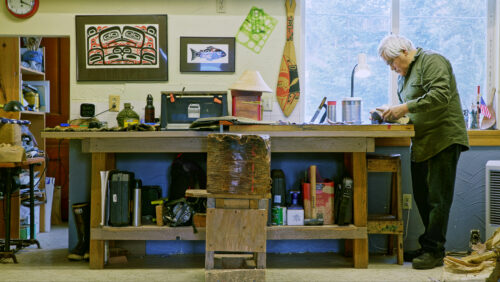
Download
Loading...
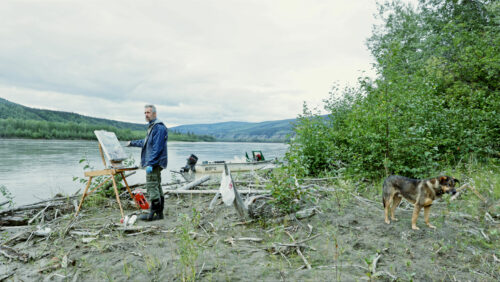
Download
Loading...
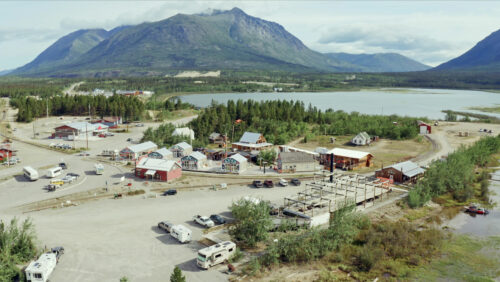
Download
Loading...

Download
Loading...
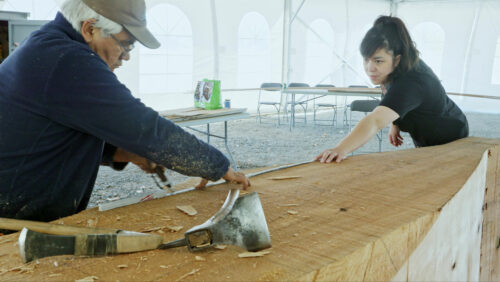
Download
Loading...
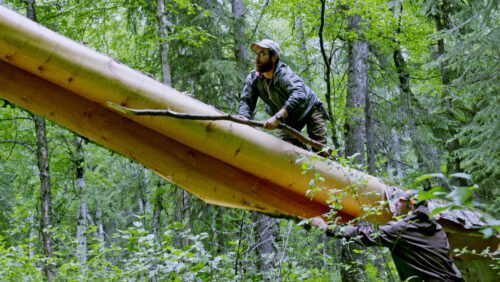
Download
Loading...
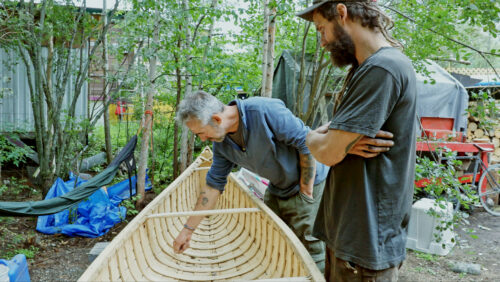
Download
Loading...
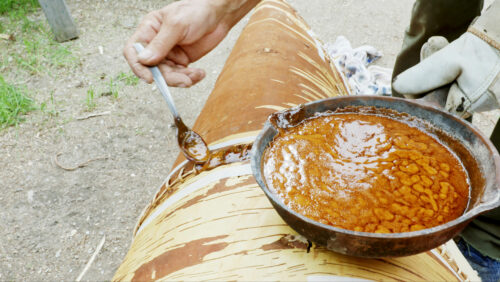
Download
Film Subjects
Loading...

Download
Loading...
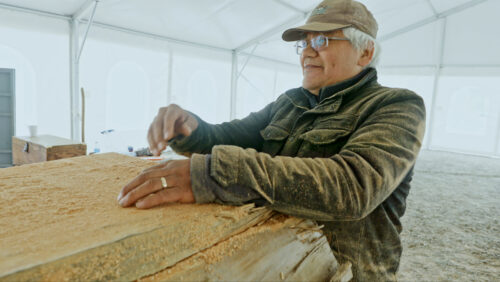
Download
Loading...
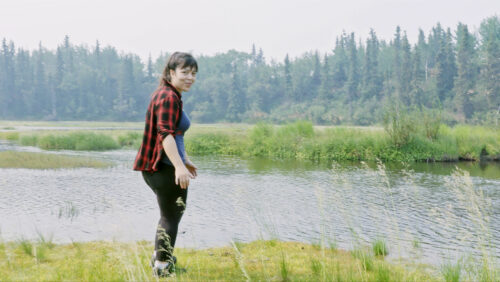
Download
Contact NFB Publicist for high-resolution images for print.
Team
Fritz Mueller
Director and Producer (Sagafish Media)
Photo
Teresa Earle
Writer and Producer (Sagafish Media)
Photo
Shirley Vercruysse
Producer/Executive Producer (NFB)
Photo
Photo : Myriam Frenette
Credits
Director
Fritz Mueller
Writer
Teresa Earle
Producers
Teresa Earle
Shirley Vercruysse
Fritz Mueller
Director of Photography
Fritz Mueller
Editors
Graham Withers
Teresa Earle
Composer
Jordy Walker
Featuring
Halin de Repentigny
Wayne Price
with
Violet Gatensby
Duncan Spriggs
Jake Armstrong
and
Joe Migwans
Tim Ackerman
Melvin Williams
Roberta Wally
Keith Wolfe Smarch
Whitney Hartigan
Cherri Price
Filmed in
Dawson City, Carcross and Whitehorse, Yukon
Haines, Juneau and Skagway, Alaska
and in the traditional territories of the Carcross/Tagish, Tr’ondëk Hwëch’in, Kwanlin Dün and Coast Tlingit
Production Manager
Teresa Earle
Location Sound
Fritz Mueller
Aerial Cinematography
Fritz Mueller
Jassin Godard
Mike Code
Archival Footage
Duncan Spriggs
Additional Camera
Bill Kendrick
Brian Ladue
Sound Editing
Stackwall Sound
Sound Design
Stackwall Sound
Sound Editors
Jordy Walker
Kyle Cashen
Post-Production Sound
Stackwall Sound
Sound Mixer
Jordy Walker
Additional Composition
Jesse Zubot
Colourist
Fritz Mueller
Title Design
Jenn Strom
Graphic Design
Mary Binsted
Closed Captioning
Line 21 Media Services
Post-Production Coordinator
Teresa Earle
Paddlers
Richard Malvasio
Bamby James
Waughnita James-Elton
Emily Sheakley
Herb Kaaxh Tséen Sheakley Jr
Rose Willard
Andrew Robinson
RJ Santos
Claus Schytrumpf
Michel Vincent
Support Boats
Tommy Taylor
Adam Zenger
Also appearing
Max Vincent
Ted Hart
Justin Smith
Jack Smith Sr
Jack Smith Jr
Stuart Schmidt
Jerry Mosure
Walter Cameron
Charlie Burns
Harold Gatensby
Phil Gatensby
Colleen James
Eileen Wally
Bessie Jim
Daisy Gatensby
Ryker Johns
Ben Gribben
Ali Khoda
Gisela Niedermeyer
Leslie Hamson
Theo Stad
Bear the dog
Carvings and Dugout Canoes
Wayne Price
Paintings and Birchbark Canoes
Halin de Repentigny
Songs
Chilkoot Entrance Song
Tlingit song written by Lance Twitchell
Performed by Wayne Price, Justin Smith and Ted Hart
St. Anne’s Reel
Traditional Canadian fiddle tune
Performed by Amelia Rose Slobogean
En Roulant la Boule
Traditional French-Canadian folk song
Performed by Halin de Repentigny
Daḵl’aweidí (Killer whale) Migration Song
Traditional Tlingit song with acknowledgment to Daḵl’aweidí clan
Performed by Rose Willard, Bamby James, Emily Sheakley, Waughnita James-Elton
Dawson City Bound
Song by George McConkey
Performed by George McConkey live at the Westminster Hotel
Wellington’s Advance
Traditional Irish jig
Performed by Amelia Rose Slobogean
We Used to Go
Written by Jordy Walker, Corwin Fox, Jeff Wolosewich
Performed by Jordy Walker and Jesse Zubot
Legal Services
Boughton Law
Austring Fairman and Fekete
Insurance
Front Row Insurance
Accounting
Sherrill Sirrs Inc.
Bookkeeping
Teresa Earle
Northwestel Production Executive
Mike Gravitis
The National Film Board of Canada, BC & Yukon Studio
Line Producer
Jennifer Roworth
Technical Coordinator
Wes Machnikowski
Studio Administrator
Carla Jones
Senior Production Coordinators
Nathan Conchie
Nicolas Ayerbe Barona
Marketing Manager
Kay Rondonneau
Publicist
Katja De Bock
Executive Producer
Shirley Vercruysse
Special thank you
Adäka Cultural Festival
Carcross/Tagish First Nation
Kwanlin Dün Cultural Centre
Skagway Museum
University of Alaska Southeast
Westminster Hotel
Yukon First Nation Culture & Tourism Association
Dań Kwanje ’Á–Nààn: Voices Across the Water Traditional Watercraft Project
Charlene Alexander
Mark Doucette
Shirlee Frost
Marilyn Jensen
Chris McNutt
Iris Merritt
Florence Moses
Andrew Seymour
Michelle Van Beusekom
Thank you
William Amos
David Ashley
Bryna Cable
Dan Cable
Annie Cable
Angus Cable
Elaine Cairns
Christine Cleghorn
Brian Crist
Norm Curzon
John Dempster
Chris Ferguson
Jessica Hall
Heather Harding
Tyler Hargreaves
Raffles McDowell
Gail McKechnie
Rhoda Merkel
Don Murphy
Selwyn Jacob
Bob Jickling
Wendy Jickling
Linda Johnson
Will Macrae
Fritz Mueller Sr
Sally Mueller
Robyn Mueller
Stella Mueller
Brian Nicol
Angelo Nicoloyannis
Allan Nixon
Teri Snelgrove
Stuart Snyder
Susan Stanley
Joan Turner
Daphne Vernier
Produced with the participation of Canada Media Fund
Developed and produced with the participation of Yukon Media Development
Developed with the participation of
Yukon First Nation Culture and Tourism Association
Canadian Broadcasting Corporation
Canadian Film or Video Production Tax Credit
Produced in association with Northwestel
© 2022 Sagafish Media Inc. and the National Film Board of Canada
Media Relations
-
About Sagafish Media
Sagafish Media specializes in storytelling with a northern point-of-view. We develop and produce documentaries created, shot and edited in Northern Canada. Our backyard is the circumpolar region and our films combine engaging narrative, striking visuals and universal themes that help audiences learn about these little-known worlds. In seven years we have completed three films, have two more in production and several in development. Completed films include Journeys to Adaka, Aurora Love and a co-pro with the National Film Board, Voices Across the Water. With a slate of films emerging, we’re venturing into international co-production. At the core of Sagafish Media are its two partners and creative collaborators, Fritz Mueller and Teresa Earle, and we work hard to cultivate northern talent.
-
About the NFB
For more than 80 years, the National Film Board of Canada (NFB) has produced, distributed and preserved those stories, which now form a vast audiovisual collection—an important part of our cultural heritage that represents all Canadians.
To tell these stories, the NFB works with filmmakers of all ages and backgrounds, from across the country. It harnesses their creativity to produce relevant and groundbreaking content for curious, engaged and diverse audiences. The NFB also collaborates with industry experts to foster innovation in every aspect of storytelling, from formats to distribution models.
Every year, another 50 or so powerful new animated and documentary films are added to the NFB’s extensive collection of more than 14,000 titles, half of which are available to watch for free on nfb.ca.
Through its mandate, its stature and its productions, the NFB contributes to Canada’s cultural identity and is helping to build the Canada of tomorrow.